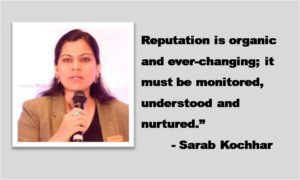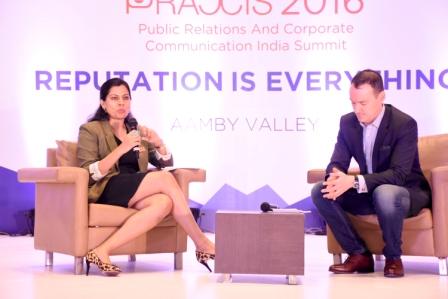
“There cannot be a more creative format on a Saturday morning!” said Gregor Halff, Chair – Global Alliance & Deputy Dean, Singapore Management University, at his Special Address.
As he started speaking on his topic: “What are PR academics good for anyway?”, he brought up certain relevant questions – What is the reputation academics have? What is the relationship between the practice and academia? What are PR academics good for, anyway?
In PR Education, he pointed out that “the gap between practice and academia is smaller than we pretend. The gap is smaller than it is!”
In fact, he went as far as saying “I think this debate is a fake! It hides something for both sides that are going well!”
Giving a remark that had a distinct stamp of his own, he said, “Academics produce ‘good enough’ graduates and the industry buys ‘good enough’ entry level graduates. I like to call it a collusive complacency”. The phrase “collusive complacency” caught the fancy of the audience and the term surfaced in the Q/A session too.
When the question of PR Research came up, he proclaimed that, “The gap between practice and academia is less harmful than we think”.
Research in the 50s was all about how PR and Journalism relate to each other. This was followed by the second wave, which was about the relationship between PR and management. The third issue was about the relationship between PR and other companies that produce content. Cutting research has moved on already, he said and that a wave of research is producing valuable content.
Focussing on the Global Communication Report, he told the audience that practitioners say that PR has got to be more complex, more strategic and more challenging. But the most important skills for practitioners of the future are: writing, strategic planning, and verbal messages.
However, PR practice is one wave behind research, and the gap between practice and academics exists. “PR practice today is preparing from the challenges of yesterday, to the challenges of tomorrow and PR research needs to identify challenges of tomorrow,” he said.
A twist in the flow of discussion came up, when PR research for tomorrow was taken up by Gregor, who brought to the forefront, an unusual situation – “What happens when robots create content?” Now, this was indeed some food for thought!
And, what can the PR business and academics achieve together? His answer: preserve the independence of research, but make it instrumental for practice and end the collusive complacency in education.
 “From Monitoring to Intelligence: Building Corporate Reputation through Research,” was the talking point for Sarab Kochhar, Director of Research, IPR.
“From Monitoring to Intelligence: Building Corporate Reputation through Research,” was the talking point for Sarab Kochhar, Director of Research, IPR.
She emphasised the importance of ‘Research’ in Corporate Reputation, right from the word ‘Go’! And, as for the gap between academics and practice, she said, “We are trying to bring it together!”
In a rapidly evolving reputation environment, the “C”-suite made up of customers, communities and conversations. With Multi-generation, plus Multi-channel Communications, it led to a diverse set of values that coalesce leadership around a common narrative. She pointed out the crisis of organisational listening, giving a chain of statistical data. On an average, 80% of organisations’ communication resources and effort are devoted to “speaking” – advertising, media releases, speeches, Web sites, tweeting, posting, etc. Libel cases prompted by social media posts rose 300% in 2014. 87% of executives rate reputation risk as more important than other strategic risks. Around 90% of large organisations and 74% of small businesses experienced information security breaches in the past year. 50% of employees who left or lost jobs kept corporate confidential data. 40% plan to use it in new roles.
What exactly, is a good reputation? According to Sarab, a good reputation influences consumer’s desire to buy your products/services, it gives credibility of your communications, it sparks off employees’ pride, investors’ confidence, legislators’ inclination to help or hinder, journalists’ disposition to report positively or negatively, NGOs’ propensity to work with or against you and last but not least, people’s willingness to hear your side of the story.
She was very clear that Research helps us – “to identify the issues and expectations that define a company’s reputation in the eyes of key stakeholders, assess relationships between organisations and publics, measure relationship outcomes and manage internal and external constituencies”.
The journey from reputation monitoring to intelligence included a number of activities: stakeholder audits, reputation audits of Internal and External Constituencies, employee surveys, consumer panels, social media monitoring and traditional media tracking. “Reputational capital is the difference, averaged over time, between market capitalisation and the liquidation value of assets,” she revealed. A comprehensive Reputation Management and Measurement Approach equation is:
Reputation = Performance + Behavior + Communication.
This takes into account, a number of factors. How the organisation is performing? How the organisation is behaving? How the organisation is communicating? And are they confusing communication with performance and behavior?
The template she presented for Comprehensive Reputation Management includes: employee talent, financial performance, social responsibility, product quality, communicativeness (transparency), governance, integrity (responsibility, reliability, credibility, trustworthiness).
Understanding PR through psychology would encompass – Behavioral Science in action, an understanding of the behaviors driving the creation of opinions from both a psychological and sociological perspective, assessment of the implications of these behaviors and then, integrate these insights into an overall strategy to build reputation.
Taking up the Cisco Case Study, she said that this paper can be downloaded from the IPR site. Highlighting the challenge here, she explained the task was to understand the overall industry narratives, learn what is most important in Cisco’s key markets, overlay Cisco’s presence within the industry network, and ensure that Cisco’s strategy remains relevant to the evolving market.
Cisco’s “one voice” was clear, and the strategy was based on the analysis provided by the network diagrams: to prioritize messaging related to the narratives most relevant in the industry, to integrate security messaging across all of Cisco’s offerings and understand the IoT vertical narratives and develop more specific, relevant industry-specific initiatives, including a case study on IoT for Oil & Gas.
And, what was the result? She was quick to disclose that Cisco’s mindshare in IoT has grown steadily due to this increased presence in key narratives. In other areas of the business, such as mobility, a much tighter integration across all areas of the business enabled communications teams to conduct a more credible data-driven business conversation with all stakeholders.
The key takeaways here, were: reputation is organic and ever-changing, it must be monitored, understood and nurtured, it must integrate digital analytics with traditional opinion research, establish a formal mechanism periodically to monitor, measure and manage reputation and, most importantly, ask the right questions.










Be the first to comment on "Academics and Research at PRAXIS 2016"